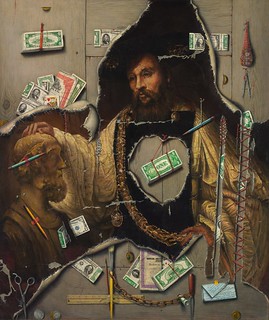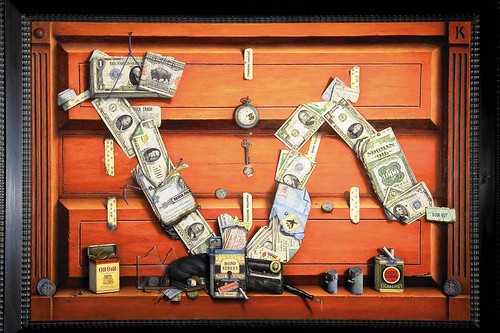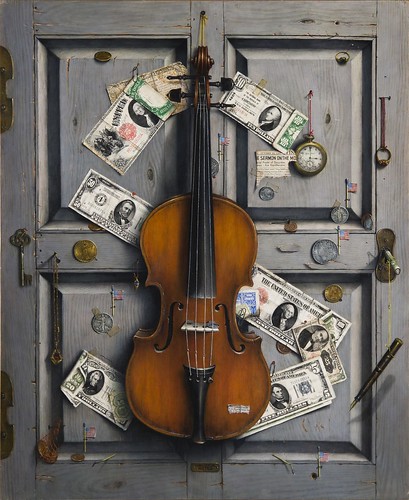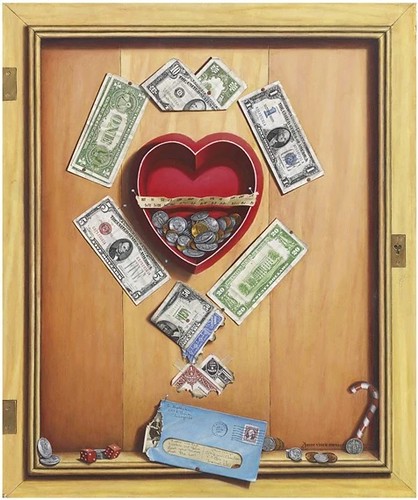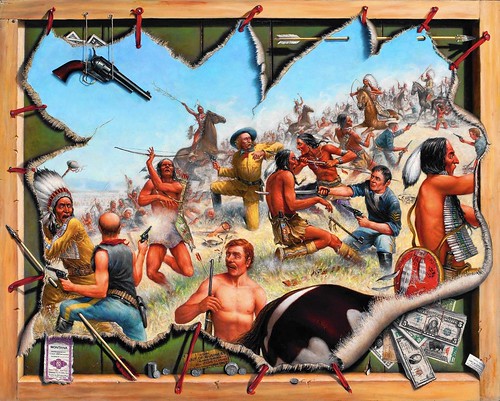
PREV ARTICLE
NEXT ARTICLE
FULL ISSUE
PREV FULL ISSUE
V25 2022 INDEX E-SYLUM ARCHIVE OTIS KAYE (1885-1974)American Numismatic Biographies author Pete Smith submitted this article on artist Otis Kaye. Thanks! -Editor A recent issue of The E-Sylum had a question about a painting by Otis Kaye. Compiling a biography was very difficult as typical biographical sources are not available.
Otis Kaye is known for including images of money in the composition of paintings. He painted
in the trompe l'oeil style, a term meaning He produced art for his own amusement and did not sell any in America. He lived frugally after 1930 and often used scraps of wood from old furniture as his painting surface. His works are so realistic it is difficult to tell from photos what is wood and what is a painting of wood. The father of Otis was Werner Kaye (1850-1903). He probably Americanized his name when he immigrated from Germany to Illinois after 1880. With his wife, Freda Kozlik (1865-1915), he returned to Dresden where Otis was born in 1885. The family returned to America and Nahma, Michigan. Werner had a lumber business and died in a mill accident in 1903. Freda took her son back to Dresden about 1904. Otis studied engineering and learned to be a draftsman and engraver. Otis married Alma Goldstein (1886-1937) in 1910. She was well educated and came from a family of means. They had a daughter Freda and a son Oskar. Otis brought his family to America and Philadelphia following the end of World War I in 1918. In Philadelphia, Kaye worked in engineering and invested his wife's money heavily in the stock market. Most of the value was lost in the stock market crash of 1929. His later paintings often reference his financial losses. After losing his job, Kaye moved his family to Chicago to join his wife's older sister Anna Kozlik (1882-1939) and her son Paul Banks II (1908-1987). Their financial hardships led Alma to take her children and return to Germany about 1935. Alma and her daughter Freda died in an accident in 1937.
Kaye, Paul Banks II, and Charles Ashe formed a civil engineering company in Chicago, JJ
Byllesby & Co. They had government contracts during World War II. During this time Kaye
paintings featured banknotes with the signature of Kaye did not limit his output to money paintings. He was a skilled engraver who made copies of some of the great artists' works in their original size. Some might have been mistaken for the originals. He also did some nudes in watercolor, painted from life. Kaye only sold two of his money paintings during his life. These were sold in Munich in 1937. Most of his paintings were stored in the garage of Paul Banks II. Many paintings had water damage and mildew damage while in storage.
Kaye had a long-time desire to return to Dresden, then in East Germany, the German Democratic Republic. He left the United States about 1969. In 1975, word filtered back to Chicago that he had died in Germany the previous year. Responsibility to manage the estate and dispose of the paintings fell primarily on Paul Banks III. A major exhibition of his works was mounted in 2015, Otis Kaye: Money Mystery and Mastery. This was shown at the New Britain Museum of American Art in Connecticut. A paperback catalog of the sale was produced. [Available on eBay for less than $5.] His works frequently included verbal puns and visual puns. Viewers of the exhibition were challenged to find hidden clues and meanings. His collected works document his life better than published biographies. Shown here are four of Kaye's paintings.
1. D'-JIA-VU (1937) Oil on Canvas 27 x 39.5 inches
2. U. S. Musical Notes (1946) Oil on Panel 30 x 24.75 inches
3. Amor Vincit Onmia (1950) Oil on Panel 30 x 25 inches
4. Custer II / Going out of Business (1958) Oil on Panel 48 x 60 inches Otis Kaye is part of a long line of money artists stretching from William Harnett to J.S.G. Boggs to Mark Wagner and others working today. See the Loose Change article elsewhere in this issue for a new article on Boggs. -Editor
To read earlier E-Sylum articles, see:
Wayne Homren, Editor The Numismatic Bibliomania Society is a non-profit organization promoting numismatic literature. See our web site at coinbooks.org. To submit items for publication in The E-Sylum, write to the Editor at this address: whomren@gmail.com To subscribe go to: https://my.binhost.com/lists/listinfo/esylum All Rights Reserved. NBS Home Page Contact the NBS webmaster 
|
